Pre-Raphaelite Women
General questions:
-
Why are these women attractive? Are they powerful or being possessed
and caught within the frame?
-
Do they represent Victorian women's positions (of being constrained,
of being either angel or whore)? Or are they signs of liberation
as the Sarah in The French Lieutenant's Woman represents at the
end of the novel?
-
Can you find contemporary counterparts to them? What are the dominant
Taiwanese images of women?
-
Please also look at specific questions about the paintings and photos.
¡@
"As artists, the women were less clearly
successful than the male Pre-Raphaelite painters. As images, however,
they dominate the scene. There are in fact three main types of
Pre-Raphaelite 'stunner,' which correspond in part to the phases of Pre-Raphaelite
art and in part to the ideas of femininity current in the Victorian age.
I. The first and earliest type--the
fair, demure, modest maiden with her innocent attractions (e.g. E.
Siddal);
II. the second--the
proud golden beauty who might borrow a term from later 'sex goddesses'
(e.g. Fanny Cornforth);
III. the third--the
dark, enigmatic Feminine (e.g. Jane Morris)" (Marsh
pp. 27-28; underline, boldface & parentheses added).
IV. The women's
roles in "The Blessed Damosel"--1.
draft; 2. final;
3. poem.
V. Christina Rossetti
as "an honorary Pre-Raphaelite Sister" ?
VI. Important Dates related to Dante
Gabriel Rossetti and the three women
|
1848 |
the formation of Pre-Raphaelite Brotherhood.
|
|
1849 |
met Elizabeth Siddal and used her as the main model (not to be used by
the others)
|
|
1856 |
met Fanny Cornforth and used her as the main model
|
|
1857 |
met Jane Morris
|
|
1860 |
married Siddal
|
|
1862 |
Siddal died
|
|
1863 |
Fanny Cornforth became somebody else's housekeeper.
|
|
1865 |
used J. Morris as the main model
|
|
1871 |
Dante Gabriel Rossetti criticized as "the Fleshly School of Poetry"
|
|
1882 |
Dante Gabriel Rossetti died
|
|
|
I. Elizabeth
Siddal As a milliner's daughter, she lived
under very limited circumstances when she met DGR.
"Rossetti fell in love with the
pale, red-haiired milliner and transformed her life by encouraging her own
pursuit of art" (Marsh 21). |
|
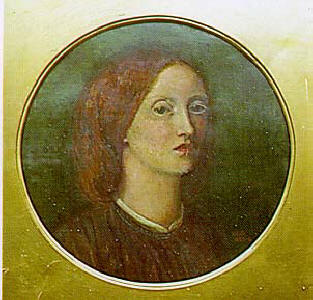
|

|
|
Self Portrait, 1853-4
Elizabeth Siddal, .
How are the above two paintings different? |
.Portrait of Elizabeth Siddal, 1854
Dante Gabriel Rossetti, |
|
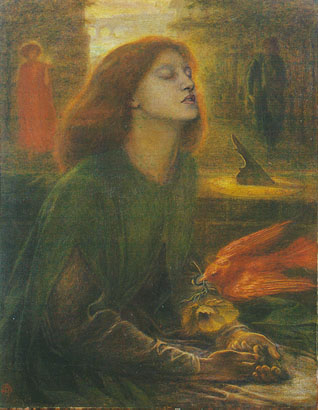
|
"...Beata Beatrix, inspired by DAnte's Vita Nuova and portraying
the beloved at the moment of her transition from earth to heaven, was the
artist's mourning tribute to his wife... [It] has always been interpreted
as a strong if somewhat sentimental token of the artist's grief and guilt,
.... It is, however, also a truly marcabre image, of the beloved
woman at the moment of death, painted in the sensuous style of Rossetti's
middle period, and its sense of necrophiliac longing is hard to evade"
(Marsh 141-42).
-
pay attention to the use of symbols: the man (Dante) and the woman (Love)
at the back, the sundial, the red dove, etc.
|
|
Beata Beatrix 1864-70
D. G. Rossetti |
|
|
II. Fanny Cornforth--Originally
a prostitute, Fanny "sat for many of Rossetti's 'vision of carnal loveliness'"
(23)
|
|
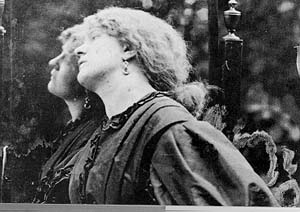
|
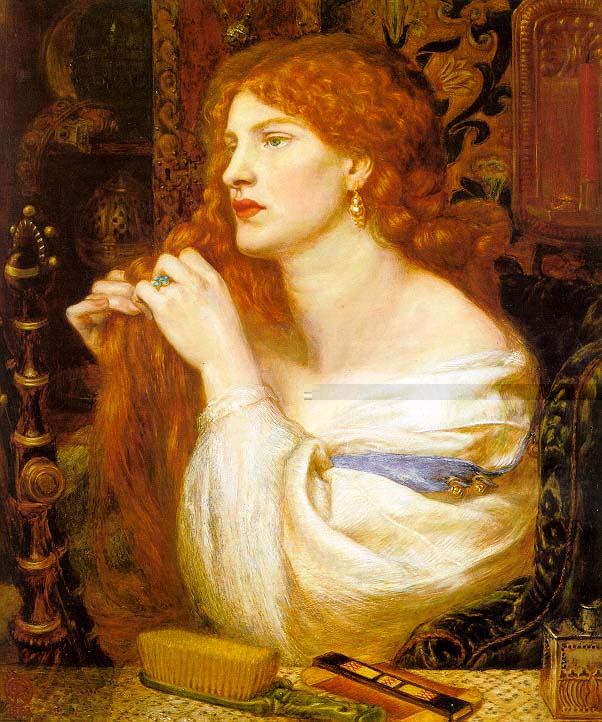
|
|
Photograph of Fanny Cornforth, 1863
W. and D. Downey ("Rossetti's meeting with Fanny altered
[his view of prostitution as moral filth and contagion] and his poem 'Jenny'
was a possible result of this revaluation" Marsh 84) |
Fazio's Mistress, 1863.D.G.Rossetti
(loose, luxuriant hair was an emblem of female sexuality
in Pre-Raphaelite painting...[Here] we may well have a clue to the rippling
effect of so much Pre-Raphaelite hair. After washing, the tresses
were plaited while still wet--as Fanny is shown doing--and then allowwed
to dry, creating a naturally crimped look Marsh 23.) |
|
III. Jane Morris
cast as Pandora, Prosperine and the poor Pia. Why? To show
DGR's love for her, sympathy with her conditions, or to contain her power
in his paintings? |
|
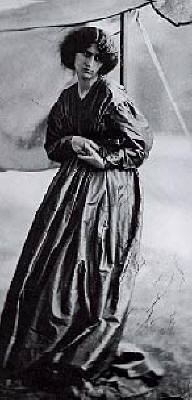
|
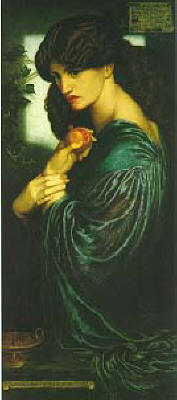
|
|
photograph of Jane Morris, 1865
John R. Parsons (Marsh 26) |
Dante Gabriel Rossetti
Prosperine, 1877. (captive in the underworld, because
she has eaten pomegranate seeds, shown here in carnal red. Marsh 144) |
|
How are these two different? |
|
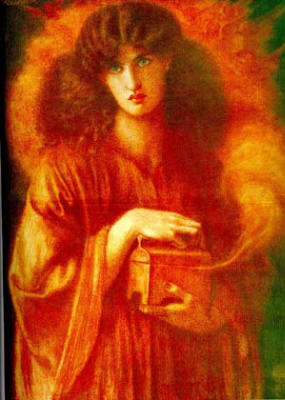
|
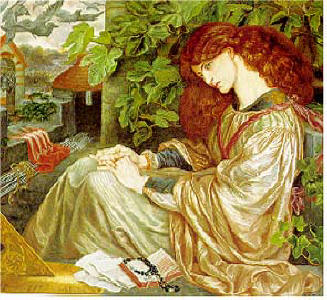
|
|
Dante Gabriel Rossetti, Pandora, 1869. (Marsh 27) |
.La Pia De'Tolomei (story from Dante, about poor Pia,
imprioned by a cruel husband in a fortress where she dies of despire and
disease, Marsh 144-145)
D.G. Rossetti, 1868-90. |
|
IV. The Blessed
Damosel
|
|

Dante Gabriel Rossetti
The Blessed Damozel, 1875-1878
The Harvard University Art Museum
(Fogg Art Museum) Cambridge, Massachusetts;
Bequest of Grenville L. Winthrop
|
|
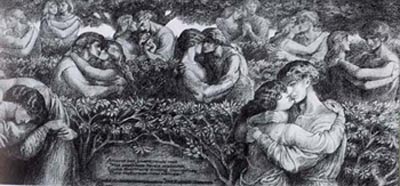
study for lovers in The Blessed Damozel, 1876 Dante Gabriel
Rossetti, (Marsh 57) (The two female figures in
the foreground are modelled on Jane Morris.)
|
"Around her,, lovers, newly met
'Mid deathless love's acclaims,
Spoke evermore amongst themselves
Their rapturous new names." |
|
|
V. Christina Rossetti--"As
a young woman she possessed a fierce wit and strong emotions, visible
in her writing; with her liverly interest in the Brotherhood and her own
poetic contribution to The Germ, she may almost be counted
as an honorary Pre-Raphaelite Sister" (underline added Marsh 34)
|
|
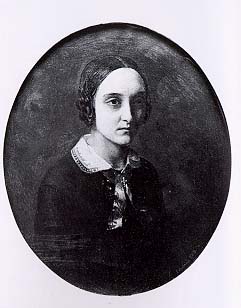
|

|
|
Christina Rossetti, c.1850
James Collinson, a PRB member (Marsh 32) |
Ecce Ancilla Domini,1850
Dante Gabriel Rossetti, (Marsh 33) |
|
C. Rossetti was engaged to Collinson while the portrait
above was in progress. in 1850, Collinson resigned from the Brotherhood
and rejoined the Catholic church; at the same time he renounced his engagement,
to C. Rossetti's relief. (32) |
How are these two paintings different?
|
|
References:
Jan Marsh.
The Pre-Raphaelite Women: Images of Femininity in Pre-Raphaelite Art
. London: Weidenfeld and Nicolson, 1987.
Richard Altick. Victorian
People and Ideas. NY: Norton, 1973.
(external) Literary Criticism Databank: Cultural Studies
Literary Criticism Databank: Cultural Studies |


